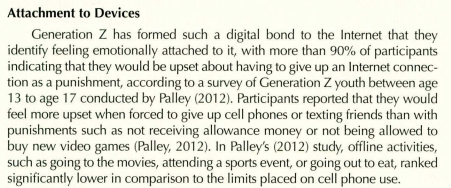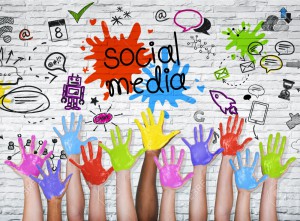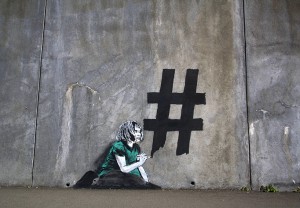Lets Talk Participation.
Participation when we think of it can best be described or defined as the act of taking part in or as much as being a part of. Participation in the ‘real’ world requires less work than in the online world. In the ‘real’ world the act of living is essentially participation because a person is actively eating, breathing, and carrying out other functions of a living inhabitant. However, in online participation is only recognized if the member is actively contributing to the community in which they are a part of. Participation online requires a great deal of dedication and obsession on some parts. An individual must invest and set aside time to be active and take part in an online discourse community. In the experimentation of detaching myself from all social networking sites was I able to see exactly how participating beyond these social sites are effected. ‘Signed Off’, the project was setup in such a way that all means to social media and all that it comprises was completely shut-off to me. With this detachment, came the ability to see just how my participation has become biased and construed based on what my attention span was narrowed in upon. With the detachment also came the ability to widen my range of participation. To fully understand participation and how it is effected by social media let us begin by fully understanding how social media users are expected to participate and the ways in which these sites encourage participation.
What Do We Want? Participation! When Do We Want It? All The Time!
According to Pewinternet.org 1 , from 2005-2015 almost 65% of the general adult population now takes part in social networking sites such as Facebook, Twitter, and Instagram. These platforms not only constantly invites participation, but creates it through data and meta-data collection. Social networking sites constant upgrade features to enable the ease of participation; they allow and integrate access from multiple other platforms such as to bridge gaps and allow a constant flow of participation across the board. In reference to, Producing New and Digital Media 2 by James Cohen and Thomas Kenny, “In order to be a part of a community, you have to participate…” (11)2. It is without a doubt that this is true. In order to be recognized as a member it is expected of you to share, comment, like, create, and follow other members. Without doing these things a user is not seen as participating in a social networking site.
The disconnect I set out on completely shut off my participation. I was not sharing information, nor was I participating in other followers content. I was the bubble girl; completely signed off from social media. What I first became aware of due to this was that my participation online shifted from a digital mediated social networking space to a more face-to-face and print based world. I was timid in the initial phase due to the fact that for the longest time I had stopped participating in acts outside of school and work. My life for most of it revolved around my social media presence. I had various platforms with various personas that allowed me to share, connect, and engage with content that I found to be stimulating. As I disconnected I found myself lost, I did not have a clear sense of what I wanted participate in. I did not know what I was interested out in the ‘real’ world as sad as that is to say. So much of myself is represented in an online space that for the first few days I found it hard to imagine what I was going to do in order to either be the same person or create a new part of myself.
In order to participate in online social networking sites, it is also important to note the terms of services before you participate. Each platform has specific uses of content and it is important to understand how your content and participation within the site is construed. Cohen and Kenny state that, “You have to remember that although you may be have a creative idea, it might not fight into the creative format of the digital environment. The benefit is that you do not have to pay to play in the space, but you do not have much of say over how the platform works or how your content is used. Make sure you read the terms of service before committing to full participation.” (13)3. What they mean to say by this is to understand the terms of your participating, does your content fit? Does it belong? Do you have creative rights or does it all belong to the community? With all that said participation is not just on part of the user but of the participating community and its guidelines. Your participation within these sites are categorized as well based on if as a user you choose to create content or lurk with the sites. The content you create also categorizes your participation as in activism, charity, destruction, and such forth.
For me however, during the disconnect my participation did not come with strict guidelines, terms of services, or platform ownership policies. I was able to choose how, when, and what I participated in and the choice alone was liberating. To allow myself to participate more in the real world without the constraints of social networking sites I bought myself a coloring book. For me, my participation online dwell around a few social networking sites which allowed me to separate my academic and professional self from my more spontaneous and provocative self. On these social networking sites I would follow art, celebrity tabloids, creepy reads, basically anything that allowed me to decompress after a long day. With the lack of social media I had to challenge myself to participate in an activity which was both productive and time responsible (two things I saw social media participation to be before this experiment). With the continual day to day practices of coloring I found myself wanting to create more. I had become fond of my new hobby. Instead of participating by following art I was now the creator. I was taking part in more than just liking or tagging a friend. I became stimulated again by the magic which happens when color touches paper. In, “Participating in The World Around Me” 4, a blog post which was a part of the ‘Signed Off’ Digital Diary, I explored my new found interest and the way by which I was able to turn my participation from an outward show to an inward reflection (also see: ‘Replacing my Digital Footprint’ 5).
Moving one step further, these sites always actively encourage participation by promoting social media fame. Users who attract attention based on skills in comedy, fashion, or makeup, readily become certified as in terms of Instagram. The act of becoming certified makes engages the act of participation due to a users’ possible want to become or gain a certain level of social fame. If we take a look at social video sites such as YouTube, we can see how participation also allows this. Vloggers recommend products, take part in tutorials, and advertise. If they raise a certain level of attention and engage a high level of participation as in comments or likes they rise to becoming sponsored by product companies.
This constant back and forth not only encourages participation but creates a constant demand for it. In a time where people prefer to watch a video on a product than read a review YouTube Vloggers participation online is not only wanted but needed. In a recent Tech Insider video with millionaire YouTube sensation Lilly Singh 6 aka Superwoman, she exclaimed about her need to constantly post about what she is doing with her fans in order and if she doesn’t she is frantic. I can only speculate that this is due to her constant participation that how allowed her to feel this way. Her active involvement and participation has allowed her to reach fame and wealth; two elements which also promote and invite participation in these social sites. The affordance to have a talent seen and to become lucrative off of it drives users to invest time into taking part into these social networking sites.
With this experience, I was able to see how due to social media much of our participation is based on how we are going to be seen. We want to take part in communities, or content which presents us in a certain way. Like Ms. Singh, who wants to be seen as a comedian, us, as users either want to be seen as professional, Instagram worthy, or a Vine sensation. My participation on social media was influenced by who I wanted to be and not what represented me. This was a difficult term to come to grips with. I had very little time to properly understand what that meant due to the time restriction of the experiment but from the days I got to witness what I participated in I realized that what I participated in online had very little to do with my opinion and internal needs and wants. I wanted to involve myself with an idea because I found it trending and not because it genuinely interested me.
Essentially participation online is required for you to belong online. Your presence alone does not create or influence your identity, but the sites, people, and content you engage with does. However, it is not only what you participate in but how you do. To encourage participation it is understood by an unspoken law of social media 7 that the constant engagement is more likely to generate more attention which leads to the influx of more participation of other users. Your craze creates more participatory craze. With the use of hashtag and tagging, users are appropriating their participation, and with this act; the content goes onto encourage the creation of more content, this then causes the rise in popularity and opens the social media flood gates to more participation. This is essentially the foundation of all social networking sites. A user needs participation and needs to participate in order to be a functioning member of the community.
If as a user you constant engage in participating in posts that of interest to you not only does it build your identity online but also draws attention to those you are engaging with but opens the door for collaborative participation. Take for instance, the pages you like on Facebook opens doors to networks of people from the past. Constant participation in posting on Instagram allows a user to become easily found and build and audience who wants to participate in the trends and fads you set. On Tumblr, blogging at all times allows you to flood dashboards and causes more users to follow you and spread you. A users’ constant engagement creates participation for others as well as stimulates their own participation. However, not everyone sees it this way; Lee Odden, CEO and editor for TopRank 8 Online Marketing, published, “5 Tips For More Impact From Social Media Participation” 9, in it he states that despite all the facts I have stated that,
The point of social media engagement isn’t about participation and that’s the big disconnect for a lot of people. Engagement and participation are a means to a bigger picture end. The mistake I see a lot of people making in regards to social media participation and with content market too, is that they evaluate individual messages, content, or social objects vs. seeing the effect those social and content objects have as a whole.
Well, maybe, Lee Odden did agree in some way with this explanation I have been compiling. However, I can say that from a personal stand point that participation is based on the evaluation of the individual message and the only reason I say this is because of ‘Signed Off’ which may be biased but I do think that if we were to disconnect and return our participation online would drastically because we would realize that what we are interested in is potentially not what we have determined for ourselves but the curation of content around us in on these platforms. The individual message is what determines what we participate in online. However, due to hyperconnectivity it is hard for a user to see that his or her participation is a manipulation by social networking sites to get us to continuously participate.
According to, Jean-Sébastien Chouinard, author of, “When Hyperconnectivity Leads to Social Alienation” 10, he states, “They never stop, never take a single moment to disconnect. They have no patience: they need to stay constantly occupied, constantly stimulated. They’re afraid of missing out. Case in point: 58% of smartphone owners one hour without checking their phones.” It was here that I noticed how my participation was being controlled beyond myself. I had become condition to always be my social networking sites. I had to have my phone because I needed to be able to take part in that conversation or share the same thing 12 other people did. I was only able to see this however from my disconnect. I was able to see how my participation had be signed over with the signing on of social networking sites. I had in some way without notice signed a contract to always participate and even if it wasn’t in ink it was not deniable.

Screen shot from “Generation Z: Technology and Social Interest” 11 — How participation in social media has led to the attachment of devices.
Without my participation in social media, I began to see that my participation was open to a variety of topics not based on any criteria in particular. I was deeply invested in creating and investing in art and content that maybe did not fit into a certain environment but satisfied my intellectual being. I created a new sense of importance with my new found participation. I was engaging in video making that was simple and to my taste. I was engaging with my iPhone outside the dictated uses of social media. I began to see symbols as hashtags more than just ways to engage both participation and attention but a tool to cultivate meaning. With the disconnect I found myself in a place where the world was open to myself again. Although, it can be argued that social media opens us to participating in events near and far it is the events that are close to us which we miss out when participating in social media. We capture the moments with the intention of involving others in our participation. The moment is more for them than it is for us and with that comes the stigma of how much we lack participation in the events around us.
Participation online in social networking sites has led to the increase of the by-stander effect offline; people stand by with their phones up recording to post to social sites like Worldstarhiphop 12 all the while thinking someone else defend or interrupt acts of violence. We must remember that our participation online should be an extension of who we are and who we are without these site. We should not be participation in communities to fluff our personality or to present ourselves in ways which create an alternate persona. Participation in social sites should allow the integration and the conversion of who we are, who we interact with, and what we essentially want to get out of a community.
Our worlds have become so mediated by social networking sites that our involvement outside of them is hard to define. We are now active bloggers and vloggers, and this is to be expected of the episteme, but what is not is our complete lack thereof participation in the world around us without social media. We have to learn that not everything requires a check in or a tag but sometimes just the memory. I hope that those of you who have read this post will consider disconnecting and participating in the moment and not to be a part of a moment and post it for the sake of a hashtag. Participation both online and off requires thought and judgment and I hope as time goes by more and more of us become more aware of this concept and the responsibility it entails.
But now you get it, participation is a two way street in social networking sites. Your involvement in content builds for others and someone else’s’ builds for another person and so on. With, ‘Signed Off’ was I able to see how my participation was generated based on popularity and not of self-interest. I found myself battling during the signed off period of two week to understand what my personal preferences of engagement beyond social media was. Did I really like all of these things or was I forced to believe as such? I also began to question where or not I was truly engaging or participating in the correct way which led me to question if the time spent participating was time best spent elsewhere.






